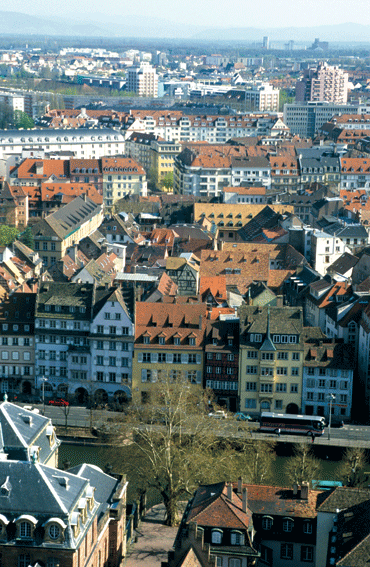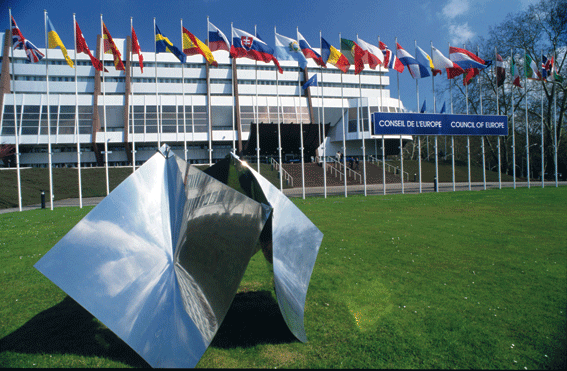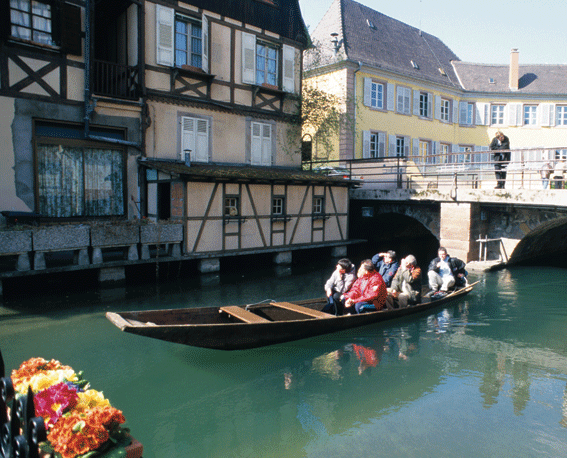
![]() Travel
Travel
 Strasbourg
Strasbourg
European and Alsatian Capital
Lying halfway between Paris and Prague, Strasbourg is known as the “Crossroads of Europe”.
By: Veronica Maria Garbutt
The city wears its cosmopolitanism with ease for it is a dynamic regional and European capital. Long, the jewel in the Alsatian crown “The City of the Roads” owes its wealth to its position on the Rhine, historically one of the great natural transport arteries of the continent.
Like Paris, Strasbourg was originally built on a defensive island in the middle of a river, but has since expanded to many times its original size (nearly half a million people now live in the area). Prosperous and progressive it has an orderliness that is Germanic rather than Latin. Indeed Alsace is a fusion of France and Germany, but the locals have a hard time thinking of themselves as French rather than Alsatian.
Sensibly Strasbourg has built the futuristic (some would say showy!) Council of Europe and European Parliament building, just beyond the old town. One of the best ways to see the “Instituts Europeennes” is to take a boat trip along the waterways encircling the historic centre. Along the way are Ponts-Couverts, covered bridges linked by medieval watchtowers. These provide a fine viewpoint for the four Ill canals and the half-timbered houses sprouting geranium thickets, and classic pavement café culture of atmospheric Petite France.
Strasbourg’s medieval commercial success was damaged by the struggles of the 16th and 17th centuries, but picked up again when it was absorbed by France in 1681. But at the end of the Franco-Prussian War the northern part of Lorraine and Alsace became part of Germany in 1871. After World War I Alsace – Lorraine became French again but was re-annexed by Germany in 1940.
Later when peace was restored post-World War II Alsace was returned to France. In order to make the region a symbol for future pan European cooperation Strasbourg became the seat of the Council of Europe in 1949. Today the locals speak Ellsassich (Alsatian), a dialect of German similar to that spoken in nearby areas of Switzerland and Germany. And street signs in both French and Alsatian have become common place.
Getting around Strasbourg is easy. The main railway station lies about 400 metres from Grande Ile, the heart of the old and new city. Much of the centre around Place Klebler, Place du Chateau and Place Broglie is pedestrianized. The rest is linked by a state of the art Network of trams and buses. At the tourist office you can buy tickets and pick up free maps along with a copy of Spectacles, a monthly listing of exhibitions, concerts, films etc.
At the core of medieval Strasbourg, Place Gutenberg was named after the pioneer of moveable type who perfected his printing press in the early 15th century. The sculptor Jean Arp was born on the corner of Rue du Vieux Marché du Poissons. On the west side stands the 16th century Hotel de Commerce from where the writer Arthur Young surveyed the destruction of the Magistrates records during the Revolution.
Be sure to take a stroll around Petite France in the early evening to savour the Alsatian charm of the area at its best. In Place Broglie lies the Hotel de Ville, the Préfet’s residence and some stately 18th century mansions. France’s stirring national anthem La Marsellaise composed by a young army engineer Claude Rouget de Lisle was first performed at No. 4 Place Broglie, then the mayor’s house. Today it is home to the Banque de France.
From here it is but a short distance to the medieval Cour du Corbeau which still looks much as it must have done in the 14th century. Downstream the old business quarter of Quai des Bateliers is interesting, especially Rue de la Krutenau and Rue de Zurich. Across the river the German quarter around Place de la Republique is well worth a visit as are the university where Goethe studied and the Grand Etablissement des Bains where you can sauna, swim or enjoy a Turkish bath.
Strasbourg is well endowed with museums, all of which offer free entry on the first Sunday of the month. Three museums (Beaux-Arts, Archéologique and Arts Decoratifs) are grouped in the Palais de Rohan; the ceramics collection is said to be one of the best in France. The Musée Historique focuses on the city’s economic and military history while the Musée Alsacien brings to life the region’s traditions, arts and crafts. For art aficionados the marvel of glass and light that is the Musée d’Art Moderne et Contemporian is a must.
Shoppers (even window shoppers) will have a field day checking out the boutiques of Rue des Hallebards with their elegant displays. After that it’s on to the chic emporia of Galeries Lafayette and Printemps or bargain priced Monoprix in Place Klebler. Second-hand goods, antiques and bric-a-brac are sold at the Marché de Brocante held every Wednesday and Saturday on Rue due Viel Hõpital. For gourmet food don’t miss the farmers’ market on Saturdays in Place du Marché aux Poissons. And for bookworms there is Place Gutenberg book fair on Tuesdays, Wednesdays and Saturdays.
Sports enthusiasts are well catered for in and around the city. Swimmers can choose from pools at Oswald and Robertson and during the summer. Wacken open air pool is the place to be. For watersports there are centres at Baggersee and Hardt Lakes. Other sporting possibilities are golf, horseback riding, racing, hunting and fishing. For sports information contact Centre d’Information de la Jeunesse tel 8837 3333.
Food lovers will find Alsatian cuisine quite different from that of the other regions of France because of its German origins. Classic dishes include sauerkraut, boiled potatoes, onion tart, river fish stew and noodles. Pastries are also popular especially tarte alsacienne made with strawberries, cherries or yellow mirabelle plums and Kugelhopf, a fancy moulded cake baked with almonds and raisins.
For a taste of local dishes check out La Choucrouterie which specializes in sauerkraut, Flams for tarte flambée and La Cloche à Fromage where you can enjoy the world’s largest cheese platter (14 total selected by an expert fromager) and sample fondue Savoyarde (cheese fondue). Arabic food is well represented too. The Lebanese Au Cedre offers good mezze while Le Sahara serves prodigious quantities of Berber-style conscous. For Tunisian tuna and slow cooked lamb tagine head for Sidi Bou Said.

If you have time to spare there is much to see and do beyond Strasbourg. Alsace is composed of two départements: Lower Rhine, the area around Strasbourg, and Upper Rhine, including the colourful département’s capital Colmar. And if you want to practise your German all you have to do is cross the busy barge laden Rhine. The northern Vosges Parc Naturel mountains which start just northwest of Strasbourg offer many hiking possibilities too. And you can stop off or stay over at a series of tiny mountain villages which give the impression of having changed little in hundreds of years.
Colmar is possibly the best preserved town in Alsace. It’s heyday was in the 16th century when merchants shipped their goods along the waterways running through the pretty canal quarter known as Petite Venise. The town’s old centre is a maze of cobbled streets and Alsatian style building from the late Middle Ages and the Renaissance. Many of the half-timbered houses are painted in pastel shades of blue, green, red and orange. And on the outskirts of town lies El Amel mosque which is also home to the town’s Cultural and Islamic Association.
Some 5km southwest of Colmar, Eguisheim village is laid out within three concentric rings of ramparts. In the centre is the octagonal feudal castle of the counts of Eguisheim. Bisected by the Grand Rue the village is known for its gabled, geranium-adorned houses, fountains and fortified towers. All in all, it has a quaint Hansel-and-Gretel atmosphere.
The best time to visit Alsace is between May and October from Spring to early Autumn. A word of warning: avoid Strasbourg on days when the European Parliament is in session as it is almost impossible to get a hotel room then, and if you do, you will be paying premium prices. Bon Voyage!